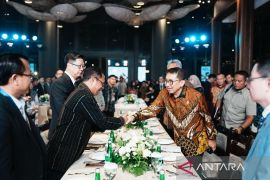With confident economic growth, ASEAN aspires to become the world’s fourth-largest economy by 2030, advancing toward building a dynamic and innovative community.
The path forward involves leveraging innovation as a foundational strength to unlock untapped potential for ASEAN's long-term growth and sustainable prosperity.
The key question is "What will be the game changer?" and the answer lies in the power of intangible assets.
As outlined in the ASEAN Community Economic (AEC) Vision 2045, focusing on nurturing and developing the intangible economy holds the key to driving productivity, innovation, and sustainable economic growth, positioning ASEAN as a future global epicenter.
Unseen power
In today’s global economy, intangible assets have become the primary drivers of innovation and competitiveness.
These assets encompass elements such as research and development (R&D), know-how, software and data, design, brands, reputation, and organizational expertise. Though often unseen, intangibles are vital in a knowledge-based world, reshaping how value is generated globally, and how wealth and prosperity are distributed.
As the global economy increasingly relies on knowledge and innovation, the value and impact of intangibles are profound. In 2023, the global intangible value reached nearly US$62 trillion, an eight percent increase from over US$57 trillion in 2022.
Investment in intangible assets reached US$6.9 trillion in 2023, growing at three times the rate of tangible investments since 2008.
Sectors prioritizing intangibles have recorded 28 percent higher growth in Gross Value Added (GVA) than others, whereas companies heavily investing in intangibles outperform and generate 2.6 times more GVA than their peers.
In fact, 90 percent of the value of the world’s top 500 companies is derived from their intangible assets, proving that most valuable firms enhance their competitiveness and market value from intangible rather than “tangible” capital.
The importance of intangible assets extends beyond individual businesses to the prosperity of countries and regions.
Countries prioritizing intangible investments consistently outperform others, with such investments accounting for over 16 percent of the gross domestic product (GDP) in highly intangible-intensive economies.
Developed countries have shown strong economic resilience, particularly during crises like the COVID-19 pandemic, when intangible investments allowed businesses to pivot swiftly and maintain productivity.
For ASEAN, leveraging intangible assets is no longer an option, it is an imperative. By unlocking the region’s intangible assets, ASEAN can transform this moment of promise into a legacy of tangible growth, securing its position as a global leader in innovation, productivity, and prosperity.
Has ASEAN been ready?
ASEAN stands at a promising position, poised to harness the transformative power of intangible assets, supported by a dynamic economic landscape, decades of investment in education and social improvements, a youthful population, a strong IP-driven innovation ecosystem, thriving SMEs, and an expanding digital economy.
As the world’s fifth-largest economy, ASEAN's combined GDP exceeded USD3.8 trillion in 2022, with total trade having reached USD3.5 trillion in 2023.
Nearly half of the region’s population of 680 million is under 35, providing a skilled labor force ready to drive innovation and fuel the growth of intangible assets.
Over the past decade, ASEAN has strengthened its efforts to promote innovation through various initiatives in research and development (R&D), intellectual property rights (IPR), and support for SMEs and startups.
Between 2012 and 2022, the region experienced a 70 percent increase in patent applications, an 80 percent rise in industrial design filings, and a 110 percent surge in trademark applications.
Gross R&D expenditure has quintupled from USD10.6 billion in 2002 to USD54.9 billion in 2023.
Consequently, ASEAN has become a leader in high-tech exports, climbing from USD303 billion in 2013 to USD598 billion in 2022, with five member states in the top 10 globally for high-tech exports.
The latest 2024 GII shows three ASEAN countries among the top eight fastest movers of the index, with six entering the top 55 out of the 133 economies.
SMEs and startups, which constitute over 97 percent of the ASEAN enterprises, play a crucial role in job creation and GDP growth.
In 2022, ASEAN attracted US$110 billion in venture capital, a 60 percent increase from pre-pandemic levels, while the number of unicorns has grown from two in 2014 to over 50 today.
ASEAN Member States (AMS) have made significant strides in digital adoption, creating new opportunities for innovation and intangible asset development.
The region’s digital economy is projected to reach USD1 trillion by 2030, driven by growing internet penetration and an increasingly tech-savvy population.
The ASEAN Digital Economy Framework Agreement (DEFA) aims to further enhance this growing commitment to the digital economy, aiming to uplift the regional GDP by USD2 trillion by 2030.
However, challenges remain that impede the full unlocking of intangible assets, and ASEAN is actively addressing these hurdles.
The region is making strides towards reducing its reliance on imported technology while increasing its R&D investments. Significant progress has been made in improving IP regulations, and efforts are underway to strengthen the enforcement of IPR and bridge the digital divide.
Meanwhile, the pace of digital adoption varies, with some AMS advancing rapidly while others gradually enhancing their digital infrastructure, internet access, and tech literacy.
ASEAN is committed to minimizing this disparity, ensuring all member states can fully participate in and benefit from digital transformation, thereby optimizing the advantages of intangible assets across the region.
Furthermore, there is a growing opportunity for many SMEs in the region to transition from importers to exporters of home-grown technological solutions, enhancing their competitiveness.
This shift will involve embracing innovation through new business processes and product designs, supported by improved access to funding for R&D and digitalization.
ASEAN's strategic position in supply chains and economic mobility provides a strong foundation for enhanced intra-ASEAN cooperation, allowing member states to fully capitalize on these inherent advantages.
Charting ASEAN strategic pathway
As ASEAN stands on the brink of transformation, unlocking its intangible assets is crucial for achieving ambitious economic goals and realizing the AEC Vision 2045. There are several key strategic pathways towards achieving this vision:
First, investing in a regional innovation ecosystem that empowers SMEs and startups is crucial. To fully leverage intangible assets, ASEAN must foster a robust innovation ecosystem that champions small- and medium-sized enterprises (SMEs) and startups. Investment in incubators, accelerators, and funding mechanisms can provide the necessary support to help these businesses flourish.
Facilitating access to mentorship programs, grants, and venture capital will empower SMEs and startups to innovate, develop IP, and reach their full potential. This proactive approach will nurture a vibrant entrepreneurial landscape that fuels the region's economic growth.
Second, strengthening IP protection and IP valuation is fundamental for nurturing innovation and safeguarding intangible assets. Stronger IP frameworks and consistent enforcement across member states can boost R&D investments and attract higher levels of foreign direct investment, leading to greater innovation. ASEAN should advocate for stronger IP laws and consistent enforcement across member states. Improved IP valuation practices will empower regional businesses to recognize and leverage their intangible assets effectively, fostering a culture of respect for IP and attracting more sustainable domestic and foreign investments.
Third, advancing digitalization and talent development while bridging the digital divide is critical. Investing in digital infrastructure and prioritizing Science, Technology, Engineering, and Mathematics (STEM) education and digital skills training will ensure the workforce thrives in a knowledge-driven economy. Moreover, as digital transformation progresses, addressing the widening digital divide will enable all ASEAN nations to fully participate in and benefit from the digital economy. By fostering a tech-savvy population and ensuring equitable access to digital resources, ASEAN can unlock new opportunities for innovation and economic participation.
Fourth, deepening regional cooperation and integration is imperative. ASEAN should focus on sharing best practices, harmonizing policies, and creating regional innovation hubs to facilitate knowledge exchange and collaboration. Aligning with the post-2025 vision, the focus will be on IP commercialization strategies and establishing a unified IP register to streamline IP management across the region. This cooperative effort will enhance ASEAN's collective competitiveness in the global market and foster a unified innovation ecosystem, enabling member states to capitalize on their unique strengths and drive innovation.
At this transformative juncture, the opportunity to unlock ASEAN's immense potential of intangible assets for growth, innovation, and prosperity is now. By investing in our innovation ecosystems, enhancing IP frameworks, fostering digitalization, and deepening regional collaboration, we can turn intangible assets into tangible growth.
“Our decision and dedication to strategically unlock intangible assets are key to ASEAN’s future. Through our united efforts to ignite this power, ASEAN will not only secure economic prosperity but also ascend as a global leader in innovation. Let us embrace this moment to define a lasting legacy of a resilient, innovative, dynamic, and people-centered ASEAN for generations to come,” Secretary-General of ASEAN Dr. Kao Kim Hourn stated.
*) Satvinder Singh is the Deputy Secretary-General of ASEAN for ASEAN Economic Community
*) The views and opinions expressed on this page are those of the author and do not necessarily reflect the official policy or position of the ANTARA News Agency
Related news: RI outlines three cooperation sectors to boost ASEAN-Japan economy
Related news: Equal digital infrastructure distribution can boost competitiveness
Copyright © ANTARA 2024












